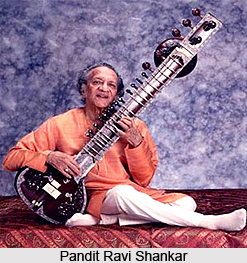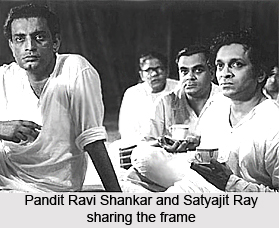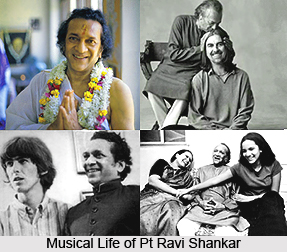 The unparallel sitar maestro, Pandit Ravi Shankar the pole star amidst the tempest tossed arena of music, is the bridge who spearheaded east meets west upheaval. Every adjective, falls short to express the stature of this man`s genius; the seed of a musically inclined family and it was but innate that he would venture with music as the food for his being, his sole quest. His talent, though dormant in his boyhood was spotted by Ustad Allauddin Khan who had been the guide and disciplinarian behind moulding Ravi Shankar the name he is today. He was trained to perfection by Baba, and the world gets to witness Ravi Shankar and his sitar to the intimate best. Power, fame and money arrived to his feet quite during the dawn of his career, because Ravi Shankar knew exactly how to ride on the high tide of the musical frenzy with his rare talent. He was looked at with awe and veneration in the country, and his popularity in the west was like a spiritual `guru` or messiah salvaging every rebellious youth to the right path. Ravi Shankar was a genius with his sitar and the peak of his creative enterprise records numerous improvisations to his favourite instrument. His recitals are dumbfounding; his raagavistaar is serene and takes one onto the flow of the rhythm. His contribution to the world of classical music is yet-to-be-surpassed by any amateur.
The unparallel sitar maestro, Pandit Ravi Shankar the pole star amidst the tempest tossed arena of music, is the bridge who spearheaded east meets west upheaval. Every adjective, falls short to express the stature of this man`s genius; the seed of a musically inclined family and it was but innate that he would venture with music as the food for his being, his sole quest. His talent, though dormant in his boyhood was spotted by Ustad Allauddin Khan who had been the guide and disciplinarian behind moulding Ravi Shankar the name he is today. He was trained to perfection by Baba, and the world gets to witness Ravi Shankar and his sitar to the intimate best. Power, fame and money arrived to his feet quite during the dawn of his career, because Ravi Shankar knew exactly how to ride on the high tide of the musical frenzy with his rare talent. He was looked at with awe and veneration in the country, and his popularity in the west was like a spiritual `guru` or messiah salvaging every rebellious youth to the right path. Ravi Shankar was a genius with his sitar and the peak of his creative enterprise records numerous improvisations to his favourite instrument. His recitals are dumbfounding; his raagavistaar is serene and takes one onto the flow of the rhythm. His contribution to the world of classical music is yet-to-be-surpassed by any amateur.
In India Ravi Shankar`s name, at least in the media and the popular imagination, has become synonymous with the sitar; in the west, especially in the US and UK, his name has become equivalent with all that is `spiritual` and wonderful in Indian classical music as a whole. Ever embraced by the Western Counterculture, his name is inveigled into the nooks and crannies of popular culture. No other Indian musician has as many feathers to ones crown as he, none as adulated as he. This eminent musician who took Indian classical music to the most distant of shores was the disciple of Ustad Allauddin Khan. He is the foremost of Baba`s (as Allauddin Khan was called by all who loved him) disciples in terms of the fame he achieved. Ravi Shankar, through a combination of good fortune, numerous innate gifts and that uncanny knack for coming of age at the right time in the international cultural history, became the ambassadorial face of Indian classical domain. The name is the stamp itself.
Early Life of Ravi Shankar
A Bengali Brahmin by caste, Ravi Shankar was born in Varanasi in 1920 born as Robindra Shankar; youngest of four brothers. Sharing an intimate camaraderie with poverty during childhood, Shankar was brought up by his mother; his father often indulging in the distant calls of wilderness -a trotting lawyer, philosopher, writer, and former minister to the Maharaja of Jhalwar who had moved to Europe with his English wife. Robu as he was dotingly called was by far the white sheep of the herd, the cynosure of family eyes. His elder brother was Uday Shankar who in the year 1930 uprooted the family to Paris, and the next eight years saw him basking in glory and limelight in Uday`s troupe. Baba Allauddin Khan, who was associated with Ravi Shankar`s brother Uday Shankar`s ballet troupe for a while, began to take an active interest in the lad`s musical training. Until he met Baba, Ravi Shankar showed no serious interest in music. Baba soon took the youngster over to Maihar state, whose court musician he was and began training him along with his own son, Ustad Ali Akbar Khan. Though Baba was a sarodiya, he trained Ravi Shankar in the sitar. Such was his (Baba`s) versatility.
In a period of five years he made the obstinate Ravi Shankar as supple as the strings of a sitar. The five gruelling years with Baba were times of hard practice. Through love, affection, and at times terrible chidings and beatings, even misunderstandings, Baba was able to mould Ravi Shankar into a perfect gentleman and a sitarist. The tale of his growth from strength to strength from the 1950s, culminating in his international stature from the 1960s, made him the envy of every one of his contemporaries. Ravi Shankar had scored the music for Satyajit Ray`s classic Pather Panchali about this time. This greatly boosted his stature in national and international circles.
At the conclusion of studentship, he was also offered the hand of Baba`s daughter, Annapurna Devi, the only living woman instrumentalist of peerless genius in the country. Since 1960, Ravi Shankar started residing in the US for longer periods until he eventually decided to settle in the West Coast for good. During the 1960s, a major cultural and political upheaval swept the western nations, and the rebellious and disillusioned youth looked for alternative modes of thinking and feeling. They rejected their own culture and religious inheritance, and suddenly discovered that Indian music was more `spiritually` enlightening. Indian classical music, more specifically, Ravi Shankar`s sitar was thought to be the epitome of all that was profound and mystical in Indian spiritual traditions. Sure enough, Ravi Shankar became a rage among a good section of the Flower Children in the West Coast. He eagerly went with the flow and garnered rich benefits on several fronts at once. Both Ravi Shankar and his one-time brother-in-law, Ali Akbar Khan performed many successful jugal bandis, riding the wave of popular appeal all the way through 1960s and 1970s. Soon many westerners assumed that the genius of Indian music began and ended with the sitar, more specifically the sitar of Ravi Shankar.
 To top it all, Ravi Shankar`s friendship with George Harrison of the Beatles, who became his disciple, added considerably to his glamour and stature in UK and the US. The Kinnara School of Music he started in the US attracted hundreds of bob-tailed enthusiasts to learn the spiritual music of India at his feet. Soon enough, he was called the emissary of Indian culture in the West.
To top it all, Ravi Shankar`s friendship with George Harrison of the Beatles, who became his disciple, added considerably to his glamour and stature in UK and the US. The Kinnara School of Music he started in the US attracted hundreds of bob-tailed enthusiasts to learn the spiritual music of India at his feet. Soon enough, he was called the emissary of Indian culture in the West.
Life in Music for Ravi Shankar
Ravi Shankar is an unequalled performer whose cultural churning most definitely is a strong confluence of tradition and modernity. His raagavistaar has become the paragon of all that is deep, compelling and meticulous in the Senia-Maihar tradition of Baba Allauddin Khan. As a classical musician, Ravi Shankar follows the style he picked up from Baba without exhibiting any departure. The powerful tone of his kharaj pancham sitar, which he designed specifically by adding one more bass string, creates a profound reverberation in the concert hall. His alaaps are tranquil, steady, and lucid in terms of mood, approach and effect. The bizarre finesse of the talim, the nurtured pedagogy, the dominance over dhrupad, the mellifluous richness of khayal, playfulness of thumri which records shankars musical legacy is the wealth from the Oriental land as he tweaked through the strings of his sitar. He never deviated from the royal road of dhrupad classicism and dignity while elaborating a raaga. All these factors are further enhanced by the been-like effects he is able to create while playing the alaap and the jod sections in all the three octaves. When he descends into the depths of the mandra sthayi, while playing on the bass strings, one hears the resonant sublimates of the rudra veena quite distinctly. It was of course Baba who told him to put the extra bass `sa` string on to his sitar in order to get the resonant bass effects. It is in this part, that he excels the most when compared to other contemporary virtuoso sitarists. Ravi Shankar`s masterly control over the instrument also helped him bring out these tonalities with poise and charm. Everything has a place in his raaga elaboration; nothing is ever overdone. The sense of equipoise is maintained all through.
Ravi Shankar`s vibrancy of tone possesses also immense rhythmic charm. He becomes an unabashed romancer of raagas here, as also an adept duellist with the tabla. His contests with great masters of the tabla like Chaturlal, Kanhai Dutt and Allah Rakha in the 1960s and the 1970s have been great events of the musical history of those eras. It was Ravi Shankar who first gave the percussionist a key role during concerts. Only in the Carnatic tradition does one find the percussionists getting the spotlight when they play a lengthy taniavartanam (solo improvisations performed by the mridangam and, at times, the ghatam player). Ravi Shankar borrowed this item and improvised it to fit into the North Indian format. The sawal-jawab which comes towards the end of a fast section where the tabla player reproduces the melody in a spirit of friendly competition with the sitarist was made popular by Ravi Shankar. More than anyone, it was he who inflated the status of the tabla player during a concert, making it a thrilling affair.
Ravi Shankar`s keen interest in the new and the novel gave him a truly liberal view of the music traditions of the country. He was open to the beauties of the Karnatic system, especially the profusion of raagas it had to offer. The music of great Karnatic singers like M.S. Subbalakshmi inspired him to borrow raagas like Simhendra Madhyamam. He also made raagas like Abhogi, Kirwani and Charukeshi a significant part of his repertoire. He also revived certain forgotten raagas like Palas Kafi, Tilak Shyam and Ahir Lalit. He also systematized a folk melody called Rasiya and gave it classical status. Creation of new raagas, it seems, was Ravi Shankar`s favourite hobby. He has created quite a handful of them and also given them very beautiful names like Parameshwari and Gangeshwari. Also, his numerous collaborative efforts with Yehudi Menuhin and other Western classical musicians will be remembered as wonderful novelties which have enhanced Ravi Shankar`s esteem as an ambassador of distinct cultures.
Ravi Shankar`s contribution of brilliant disciples to the world is also worth mentionable. As a teacher, his personality and teaching methods have a way of impressing themselves on his students. Of them, his most exceptional student is Pt. Umashankar Mishra. Shamim Ahmed Khan, Jamluddin Bharatiya, Pt. Kartick Kumar and Joya Biswas are some of the other senior disciples who have made a significant impact. Vishwa Mohan Bhatt, the renowned player of the Hawaiian guitar, also trained under him. One trait that the eminent teacher has passed on to many of his disciples is the search for novelty.
As a concert artist, Ravi Shankar is punctilious and scrupulous the traits he picked up during his lengthy sojourns in the west. There has been no question of arriving three hours late for concerts, or the likelihood of elaborately tuning his instrument on-stage, or of displays of moodiness or exuberance, no exchange of quips or friendly banter with the accompanists or the audience. His concerts give one the impression of being carefully planned ceremonies - not a minute wasted; nothing is ever out of place. Without any fear of exaggeration, one can say that Ravi Shankar brought in a new professionalism and an aggressive dynamism into the leisurely world of Indian music and helped it move out of the confines of the darbars and private soirees into the unrestricted world of the concert auditorium.
 Honours received by Ravi Shankar
Honours received by Ravi Shankar
Apart from being an honorary member of the American Academy of Arts and Letters he is even a member of the United Nations International Rostrum of composers. Besides a Bharat Ratna in 1999, which thrives to be India`s highest civilian honour, he treasured 14 doctorates, the Padma Vibhushan, Desikottam, Padma Bhushan of 1967, the Music Council UNESCO award 1975, the Magsaysay Award from Manila, Grammy`s, the Fukuoka grand Prize from Japan, the Polar Music Prize of 1998, the Crystal award from Davos, with the title `Global Ambassador` to name some, according to his foundation`s official website. Year1986 witnessed Ravi Shankar nominated as a member of the Rajya Sabha, India`s upper house of Parliament. His recording "Tana Mana", released on the private Music label in 1987, brought his music into the "New age" with its unique method of combining traditional instruments with electronics. A three times Grammy winner 2013 even has Grammy nomination for him for the album "The Living Room Sessions, Part- 1" pitted against his daughter Anoushka Shankar.
In conclusion, music appeared as a celebration for a democracy of broad minded statures, a catholicity of free conversations divested of narrow corralling or pigeon holing- cultural boundary had been reinstated by this veteran sitarist. The sitar loses its string with his December decay, with Panditji breathing his last at San Diego on 12th December 2012. The vast expanse of music is left behind; beyond the barriers of cherishing in a single lifetime; as one ruefully reminiscences the lines of Keats, "Heard melodies are sweet but those unheard are sweeter".




